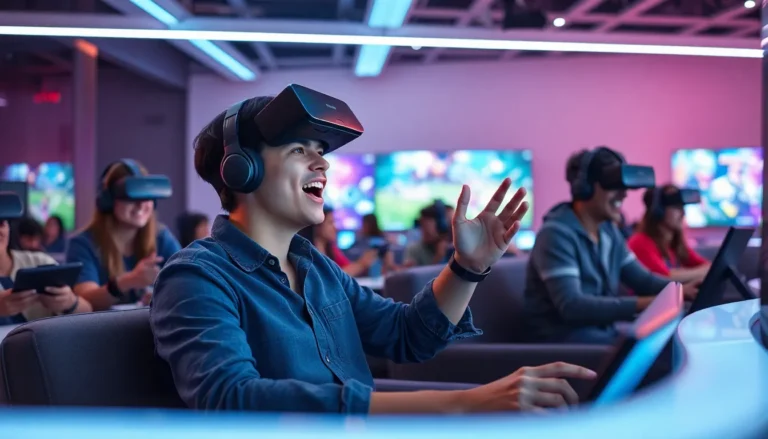Table of Contents
ToggleConsole gaming has evolved dramatically over the years, and virtual reality (VR) is at the forefront of this transformation. Gamers are no longer just passive participants; they’re stepping into immersive worlds that blur the lines between reality and fantasy. With advancements in technology, console VR is becoming more accessible, offering thrilling experiences that captivate both new players and seasoned veterans.
As major gaming consoles embrace VR, the possibilities for gameplay expand exponentially. From breathtaking landscapes to heart-pounding action, VR delivers a level of engagement that traditional gaming often can’t match. This article explores the exciting developments in console gaming VR, highlighting its impact on the gaming industry and what players can expect in the near future. Whether you’re a die-hard gamer or just curious about the VR phenomenon, there’s something here for everyone.
Overview of Console Gaming VR
Console gaming VR represents a significant advancement in the gaming landscape, combining immersive experiences with accessible hardware. Major consoles, such as PlayStation and Xbox, now integrate VR technology, enhancing user engagement. VR headsets, like PlayStation VR2, offer high-resolution displays and advanced tracking systems that create a sense of presence in virtual environments.
Key Features of Console Gaming VR
- Immersive Gameplay: Console gaming VR utilizes spatial audio and panoramic visuals, enhancing the realism of gameplay.
- Intuitive Controls: Motion-sensing controllers allow players to interact naturally with game elements, making actions feel more lifelike.
- Social Connectivity: Multiplayer VR experiences foster community interaction, enabling friends to connect and share virtual adventures.
Popular Titles in Console Gaming VR
| Title | Platform | Release Year |
|---|---|---|
| Beat Saber | PlayStation VR | 2018 |
| Resident Evil 7: Biohazard | PlayStation VR | 2017 |
| Half-Life: Alyx | PC VR (via Console) | 2020 |
| Moss | PlayStation VR | 2018 |
Console gaming VR not only enhances gameplay but also introduces new genres and experiences. Developers are creating innovative titles that leverage VR’s unique capabilities, resulting in a more compelling gaming experience. As technology evolves, console gaming VR promises to push boundaries further, offering players unprecedented adventures.
Popular Console VR Systems

Virtual reality continues to gain traction in the gaming industry, with notable systems emerging from major consoles. Below are two leading platforms in the console VR landscape.
PlayStation VR
PlayStation VR (PS VR) represents Sony’s entry into the virtual reality market. The system offers a range of features that enhance gaming experiences. PS VR utilizes a 1920 x 1080 resolution display, providing vibrant visuals that immerse players in diverse game worlds. The headset integrates with the PlayStation Camera for precise tracking, supporting full-motion capabilities.
Key titles for PS VR include “Beat Saber,” where players slice through musical beats, and “Astro Bot Rescue Mission,” an engaging platformer that showcases VR’s potential. The PS VR2, an upgraded headset, introduces higher fidelity with 4K HDR resolution and improved eye tracking, promising even more immersive gameplay.
Xbox VR
Xbox has yet to release a dedicated VR headset, but it maintains a strong presence in the evolving VR space. The Xbox Series X and Series S support VR games through cloud technologies and partnerships with platforms like Oculus. Players can access VR titles via Xbox Game Pass, expanding their gaming library without needing specific hardware.
Upcoming VR titles for this ecosystem include “The Walking Dead: Saints & Sinners,” which takes advantage of immersive storytelling. Xbox’s approach focuses on accessibility, leveraging cloud streaming to offer a variety of VR experiences on existing consoles. As the market develops, Xbox is likely to explore its own dedicated VR options in the future.
Benefits of Console Gaming VR
Console gaming VR offers unique advantages that enhance the gaming experience. These benefits include immersive experiences and increased accessibility for players.
Immersive Experience
Immersive experience defines the essence of console gaming VR. Players engage deeply with interactive environments, feeling as though they inhabit game worlds. High-resolution displays create vivid visuals, while spatial audio enhances realism. Motion-sensing controls enable intuitive interactions, allowing players to manipulate the virtual environment naturally. Titles like “Beat Saber” and “Resident Evil 7: Biohazard” exemplify this immersion, drawing players into intense, lifelike scenarios. Console gaming VR enhances emotional engagement, making gameplay feel personal and thrilling.
Accessibility
Accessibility plays a crucial role in the appeal of console gaming VR. Major consoles integrate VR technology without requiring high-end PCs, making it widely available. Advanced tracking systems and user-friendly setups minimize barriers for new users. For instance, PlayStation VR offers complete experiences with simple installation using existing consoles. Xbox, while not having a dedicated VR headset, enables access to VR titles through cloud technologies, further expanding reach. This ease of access allows diverse player demographics to explore VR gaming, fostering broader participation in this evolving medium.
Challenges Facing Console Gaming VR
Console gaming VR faces several significant challenges that may impact its growth and overall user experience. These hurdles include hardware limitations and a limited content library.
Hardware Limitations
Hardware limitations present notable challenges for console gaming VR. Consoles generally lack the processing power and graphical capabilities found in high-end gaming PCs. This disparity affects the richness and complexity of VR experiences, as developers often need to optimize games for lower specifications. The weight and fit of VR headsets also play a role in user comfort; discomfort can discourage prolonged use. Additionally, many consoles require peripherals, leading to added costs for players. Current VR systems may struggle with tracking precision, resulting in latency issues and disruptions during gameplay. With advancements in hardware and ergonomic design, addressing these limitations holds the potential for enhanced user satisfaction.
Content Library
Content library limitations hinder the immediate appeal of console gaming VR. Despite the growing number of VR titles, mainstream gaming franchises often have few dedicated VR experiences. This scarcity may deter potential players, as they seek diverse options beyond niche games. Furthermore, cross-platform compatibility remains inconsistent, restricting players’ access to specific titles. Developers face challenges in creating VR content, as the need for innovation and immersive storytelling demands significant resources and talent. Expanding the content library requires collaboration between developers and console manufacturers to produce high-quality, diverse VR games that capture a broader audience.
Future of Console Gaming VR
Console gaming VR is poised for significant advancements that promise to reshape the gaming landscape. It emphasizes enhancements in hardware, software, and game content, all working together to elevate player experiences.
Continued Hardware Improvements
Continued hardware improvements in consoles will support more sophisticated VR experiences. Higher processing power, enhanced graphics capabilities, and reduced latency will make games more immersive. For instance, next-generation PlayStation and Xbox consoles are integrating more powerful GPUs to improve frame rates and visual fidelity.
Expanded Game Libraries
Expanded game libraries will play a crucial role in the future of console gaming VR. More developers are exploring VR, leading to a greater diversity of titles. Major franchises, such as “Call of Duty” and “Final Fantasy,” may develop dedicated VR versions, attracting larger audiences. Increased investment in original VR projects will further enhance player engagement.
Social and Multiplayer Experiences
Social and multiplayer experiences in VR will continue to grow. Developers are creating games that focus on community interaction and shared experiences, as VR can facilitate unique social dynamics. Features like virtual meeting spaces and cooperative gameplay will strengthen the bond among players, encouraging them to engage together in dynamic environments.
Integration with Other Technologies
Integration with other technologies, such as augmented reality (AR) and artificial intelligence (AI), will redefine console gaming VR. Combining AR with VR can enhance gameplay by overlaying digital content on real-world environments. AI can personalize player experiences through adaptive gameplay, ensuring that content remains fresh and engaging over time.
Focus on Accessibility
Focus on accessibility remains essential in the future of console gaming VR. As technology evolves, efforts to make VR experiences more user-friendly and affordable will expand. Innovations like wireless headsets and simplified setup processes can reduce barriers for new players, promoting wider adoption across demographics.
Enhanced User Compatibility
Enhanced user compatibility will also improve VR experiences. Developers may design games compatible with a range of VR headsets, ensuring that players can enjoy content regardless of their specific devices. This approach can further drive community engagement, as players share experiences across platforms.
The future of console gaming VR showcases a landscape rich with potential, driven by technological advancements and immersive game design innovations. As the industry continues to grow, players can expect an exciting evolution in their gaming experiences.
Console gaming VR is paving the way for a new era of interactive entertainment. With immersive experiences that captivate players and enhance gameplay, it’s clear that this technology is reshaping the gaming landscape. As major consoles integrate advanced VR features, the potential for innovative titles and engaging multiplayer experiences continues to grow.
While challenges like hardware limitations and a limited content library remain, the future looks promising. Ongoing advancements in technology and game development are set to expand the possibilities of console VR. This evolution not only attracts dedicated gamers but also invites newcomers to explore the thrilling world of virtual reality. As the industry progresses, console gaming VR will undoubtedly become a staple in the gaming community, offering unparalleled adventures and experiences.







